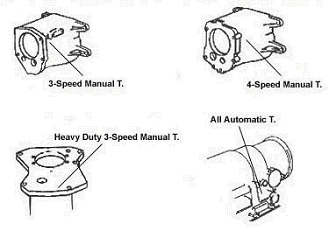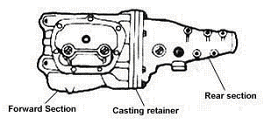The Muncie 4-speed transmission was used with many different GM models and engine combinations from 1963-1974. The basic design and operation theory of the gearbox changed little during that time, though several design upgrades and modifications were made during the total production run.
The Muncie was used with most performance engines and is not to be confused with the Saginaw or Borg-Warner 4-speeds. The Muncie is distinguished from the Saginaw in that the reverse lever on the Muncie is mounted in the extension housing while the Saginaw reverse lever is mounted in the side cover. The main difference between the Muncie and the Borg-Warner is that the Muncie has a 7 bolt side cover and the Borg-Warner has a 9 bolt side cover.
Muncie Date Coding
Many Muncie 4-speed maincases, extension housings, and sidecovers have a casting date code. On maincases the code is usually found on the passenger side of the case below the casting number. The extension housing code is usually within a few inches of the casting number also on the passenger side. Muncie casting date codes are very different from other transmission manufacturers. The code consists of two circles, both 1/2 inch in diameter and divided in half. One circle is called the date marker, the other the status marker.
The date marker has a month designator for when the part was cast or manufactured. This is represented by the numbers 1 through 12 (Jan-Dec) in the years 1963-1966. They were marked with letters as shown in the table below from then on. The opposite side of the date marker has between 1 and 5 dots representing the week of the month. The easiest way to discern the proper date mark circle is to look for the week designator spots. Always check to see that the date marked precedes the final assembly stamp code. The status marker has the latest blueprint change number on one side of the circle and a deviation notice letter on the other side if the part change letter is active. This infomation was only useful to the Muncie plant by allowing the tracking of problem parts. This circle is usually blank.
The way that the serial numbers and date codes were "coded" changed somewhat over the years. Serial numbers from 1963 to 1966 included only the month and day. P0101 would indicate January 1st. From 1967 to 1968 the serial number got a year designator and a letter designator for the month such as P8A01, meaning January 1st, 1968. One important point is that if you have a Muncie date coded with a December build date it was actually built the prior year. An example would be the date code P8T13. This is for a 1968 production car. The "T" stands
for December and 13 is the day. To confirm this simply look at the VIN number. It will usually begin with a 18S101350 or a 28N12950. This means the Muncie was assembled on December 13, 1967 for the 1968 model year. The VIN number will usually be a low number. 1969 to 1974 Muncies got a ratio designator at the end of the serial number. An example would be P4D23B. This equates to April 23, 1974, M21 ratio.
Month Code Chart
January = A |
April = D |
July = K |
October = R |
February = B |
May = E |
August = M |
November = S |
March = C |
June = H |
September = P |
December = T |
Differences in Muncie Models
Muncie
model/year |
Main Drive
gear (teeth) |
Muncie
model/year |
Countergear
teeth |
M20 1963-65
wide ratio |
24 |
M20 1963-65
wide ratio |
17
19
22
29 |
M20 1966-70
wide ratio |
21 |
M20 1966-74
wide ratio |
17
19
22
29 |
M21 1963-70
close ratio |
26 |
M21 1963-74
close ratio |
17
19
22
27 |
M22 1965-70
close ratio |
26 |
M22 1965-72
close ratio |
17
19
22
27 |
Muncie 4-speed Aluminum Component Casting Numbers
Year |
Maincase
Casting # |
Extension Housing
Casting # |
Sidecover
Casting # |
Front Bearing
Retainer Casting # |
1965 |
3851325 |
3846429*
(up till 2/65)
3857584
(after 2/65) |
3831707 |
3851326 |
1966-
1967 |
3885010 |
3857584 |
3884685 |
3851326 |
1968-
1969 |
3825660** |
3857584 |
3884685 (1968)
3950306 (1969) |
3915020 |
*The 3846429 extension was manufactured in two versions, a "thin rib" and a "wide rib".
**Muncie data shows 1968 and 1969 M22 received maincase #3925661. All documented M22 transmissions have the #3925660 maincase. It's unclear as to why this discrepancy exists.
How can you tell if the transmission in your car is the one that the car was originally built with? All original Muncie transmissions have ring grooves on the input shaft and counter gear. These grooves were put on for the Muncie assembly line workers to readily identify which input shaft to install and therefore shouldn't be used for positive identification of transmissions since many of these shafts have been replaced. Also several Muncie parts -primarily the maincase- were found to have documented "oddball" casting numbers on production vehicles. None of these maincases are shown on the origianl build records from the Muncie plant and should also not be used for identification purposes.
Many transmissions over the years have been rebuilt or replaced, upgraded from a 3-speed to a 4-speed etc. which can make identification somewhat difficult at times.
Below here are some diagrams that will describe where the serial number is stamped on all transmission cases. The 9-digit code will tell you which division, year, model, assembly plant, and car the transmission was pulled from. The first digit tells what division the transmission is built for (Oldsmobile's number is 3). The second digit is the last digit of the model year (7=1967, 9=1969, etc.). The third digit is the code for the assembly plant the car was built in. The last six digits should match the last six digits of your VIN (generally found on the door hinge of 1964-1967 models and on the left top side dash of 1968-1972 models). If the numbers don't match, your transmission has been changed, though remember that even an original transmission may have had parts swapped for repair work at some time through it's life.
 |
I found a great exploded diagram of a Muncie while surfing once. It is quite large so it is displayed on a separate page. Click here to go to that page. It is in printable form for ya!
Camaro Obsession | Body Pics | Trunk Pics | Hood Pics |
Wheel Pics
Interior Pics | Muncie Info & Pics | Miscellaneous Pics
Dealer Links | Info Links | About Us | Contact Us


